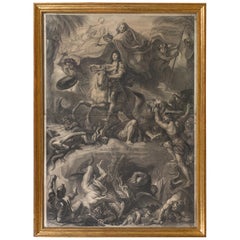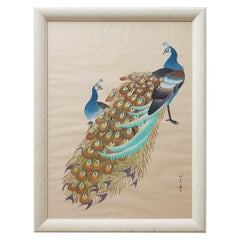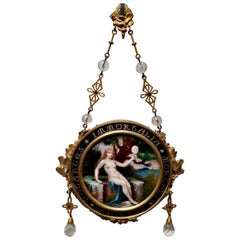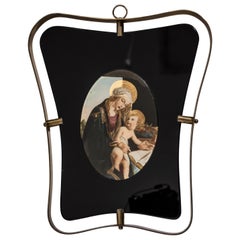Crystal Paintings
1
1
to
2
2
1
1
1
1
1
Height
to
Width
to
15,064
9,723
9,007
7,641
5,812
2
1
1
1
1
Material: Crystal
Visionnaire Peacock by Michele Astolfi
By Michele Astolfi, Visionnaire
Located in Bologna, IT
Painted glass and Swarovski crystal. Polished stainless steel frame.
Category
21st Century and Contemporary Italian Modern Crystal Paintings
Materials
Crystal, Stainless Steel
Louis XIV on Horseback, Engraved by Gerard Edelink after Charles Lebrun
Located in Saint-Ouen, FR
Louis XIV on horseback. Engraved by Gerard Edelink after Charles Lebrun,
circa 1680.
Engraving on two sheets pasted together and glued on canvas.
With frame and glass of the time.
Category
Late 17th Century French Antique Crystal Paintings
Materials
Crystal
Related Items
Japanese Showa Period Peacocks Painted on Silk
Located in Rio Vista, CA
Colorful Japanese ink and color on silk Showa painting of a pair of peacocks. Vivid colors and beautiful details with a signature and seal on right side bottom. Framed in a midcentur...
Category
20th Century Japanese Showa Crystal Paintings
Materials
Silk, Plexiglass, Paper, Wood
Early 20th Century Japanese Framed Painting, White Peacocks on Silk and Gold
Located in Kyoto, JP
Kasahara Seiken
White peacocks,
circa 1916
Framed painting. Ink, color and gofun on silk.
A Taisho period Japanese nihonga painting depicting a pair of white peacocks re...
Category
Early 20th Century Japanese Taisho Crystal Paintings
Materials
Gold Leaf
H 67.5 in W 30 in D 1 in
Italian 18th Century Oil on Canvas "Madonna and Child" after Giovanni Lanfranco
By Giovanni Lanfranco
Located in Los Angeles, CA
A very fine Italian 18th century oil on canvas "Madonna and Child" after Giovanni Lanfranco (Italian, 1582-1647). The young Virgin Mary attending to...
Category
18th Century Italian Baroque Antique Crystal Paintings
Materials
Canvas, Giltwood
H 44.25 in W 51.38 in D 3 in
After Fragonard French 19th Century Oil on Canvas Progress of Love-Lover Crowned
By (After) Jean-Honoré Fragonard
Located in Los Angeles, CA
A large French 19th century oil on canvas (laid down on a masonite) "Les progrès de l'amour dans le cœur d'une jeune fille" The Progress of Love: The Lover Crowned, after Jean-Honoré...
Category
19th Century French Rococo Antique Crystal Paintings
Materials
Masonite, Gesso, Canvas, Giltwood
H 79.25 in W 61 in D 4.5 in
Large Oil on Canvas "Beggar Boys Playing Dice" After Bartolomé Esteban Murrillo
By Bartolomé Esteban Murillo
Located in Los Angeles, CA
A fine and large 19th century oil on canvas after Bartolomé Esteban Murrillo's (Spanish, 1617-1682) "Beggar Boys Playing Dice" (The original work by Murillo was painted in 1675). The impressive artwork depicts two young boys playing dice while another eats a piece of fruit as his dog watches on., within an ornate gildwood and gesso frame bearing a label from the faming company Bigelow & Jordan. The original work by Murillo is currently at the Alte Pinakothek Museum in Munich, Germany. The present work is signed: L. Rüber. Circa: Munich, Late 19th Century.
Bartolomé Esteban Murillo (born late December 1617, baptized January 1, 1618 – April 3, 1682) was a Spanish Baroque painter. Although he is best known for his religious works, Murillo also produced a considerable number of paintings of contemporary women and children. These lively, realist portraits of flower girls, street urchins, and beggars constitute an extensive and appealing record of the everyday life of his times.
Murillo was born to Gaspar Esteban and María Pérez Murillo. He may have been born in Seville or in Pilas, a smaller Andalusian town. It is clear that he was baptized in Seville in 1618, the youngest son in a family of fourteen. His father was a barber and surgeon. His parents died when Murillo was still very young, and the artist was largely brought up by his aunt and uncle.
Murillo began his art studies under Juan del Castillo in Seville. There he became familiar with Flemish painting and the "Treatise on Sacred Images" of Molanus (Ian van der Meulen or Molano). The great commercial importance of Seville at the time ensured that he was subject to influences from other regions. His first works were influenced by Zurbarán, Jusepe de Ribera and Alonzo Cano, and he shared their strongly realist approach. As his painting developed, his more important works evolved towards the polished style that suited the bourgeois and aristocratic tastes of the time, demonstrated especially in his Roman Catholic religious works.
In 1642, at the age of 26, he moved to Madrid, where he most likely became familiar with the work of Velázquez, and would have seen the work of Venetian and Flemish masters in the royal collections; the rich colors and softly modeled forms of his subsequent work suggest these influences. In 1645 he returned to Seville and married Beatriz Cabrera y Villalobos, with whom he eventually had eleven children.
In that year, he painted eleven canvases for the convent of St. Francisco el Grande in Seville. These works depicting the miracles of Franciscan saints vary between the Zurbaránesque tenebrism of the Ecstasy of St Francis and a softly luminous style (as in Death of St Clare...
Category
Late 19th Century German Baroque Antique Crystal Paintings
Materials
Gesso, Canvas, Wood
H 69 in W 55 in D 5.75 in
After Raffaello Sanzio 1483-1520 Raphael La Madonna della Seggiola Oil on Canvas
Located in Los Angeles, CA
A fine Italian 19th century oil painting on canvas "La Madonna della Seggiola" after Raphael (Raffaello Sanzio da Urbino 1483-1520) The circular canvas depicting a seated Madonna holding an infant Jesus Christ next to a child Saint John the Baptist, all within a massive carved gilt wood and gesso frame (all high quality gilt is original) which is identical to the frame on Raphael's original artwork. This painting is a 19th Century copy of Raphael's Madonna della Seggiola painted in 1514 and currently exhibited and part of the permanent collection at the Palazzo Pitti, Galleria Palatina, Florence, Italy. The bodies of the Virgin, Christ, and the boy Baptist fill the whole picture. The tender, natural looking embrace of the Mother and Child, and the harmonious grouping of the figures in the round, have made this one of Raphael's most popular Madonnas. The isolated chair leg is reminiscent of papal furniture, which has led to the assumption that Leo X himself commissioned the painting, circa 1890-1900.
Subject: Religious painting
Measures: Canvas height: 29 1/4 inches (74.3 cm)
Canvas width: 29 1/4 inches (74.3 cm)
Painting diameter: 28 1/4 inches (71.8 cm)
Frame height: 57 7/8 inches (147 cm)
Frame width: 45 1/2 inches (115.6 cm)
Frame depth: 5 1/8 inches (13 cm).
Raffaello Sanzio da Urbino (Italian, March 28 or April 6, 1483 - April 6, 1520), known as Raphael, was an Italian painter and architect of the High Renaissance. His work is admired for its clarity of form, ease of composition, and visual achievement of the Neoplatonic ideal of human grandeur. Together with Michelangelo and Leonardo da Vinci, he forms the traditional trinity of great masters of that period.
Raphael was enormously productive, running an unusually large workshop and, despite his death at 37, leaving a large body of work. Many of his works are found in the Vatican Palace, where the frescoed Raphael Rooms were the central, and the largest, work of his career. The best known work is The School of Athens in the Vatican Stanza della Segnatura. After his early years in Rome much of his work was executed by his workshop from his drawings, with considerable loss of quality. He was extremely influential in his lifetime, though outside Rome his work was mostly known from his collaborative printmaking.
After his death, the influence of his great rival Michelangelo was more widespread until the 18th and 19th centuries, when Raphael's more serene and harmonious qualities were again regarded as the highest models. His career falls naturally into three phases and three styles, first described by Giorgio Vasari: his early years in Umbria, then a period of about four years (1504–1508) absorbing the artistic traditions of Florence, followed by his last hectic and triumphant twelve years in Rome, working for two Popes and their close associates.
Raphael was born in the small but artistically significant central Italian city of Urbino in the Marche region, where his father Giovanni Santi was court painter to the Duke. The reputation of the court had been established by Federico III da Montefeltro, a highly successful condottiere who had been created Duke of Urbino by the Pope - Urbino formed part of the Papal States - and who died the year before Raphael was born. The emphasis of Federico's court was rather more literary than artistic, but Giovanni Santi was a poet of sorts as well as a painter, and had written a rhymed chronicle of the life of Federico, and both wrote the texts and produced the decor for masque-like court entertainments. His poem to Federico shows him as keen to show awareness of the most advanced North Italian painters, and Early Netherlandish artists as well. In the very small court of Urbino he was probably more integrated into the central circle of the ruling family than most court painters.
Federico was succeeded by his son Guidobaldo da Montefeltro, who married Elisabetta Gonzaga, daughter of the ruler of Mantua, the most brilliant of the smaller Italian courts for both music and the visual arts. Under them, the court continued as a centre for literary culture. Growing up in the circle of this small court gave Raphael the excellent manners and social skills stressed by Vasari. Court life in Urbino at just after this period was to become set as the model of the virtues of the Italian humanist court through Baldassare Castiglione's depiction of it in his classic work The Book of the Courtier, published in 1528. Castiglione moved to Urbino in 1504, when Raphael was no longer based there but frequently visited, and they became good friends. He became close to other regular visitors to the court: Pietro Bibbiena and Pietro Bembo, both later cardinals, were already becoming well known as writers, and would be in Rome during Raphael's period there. Raphael mixed easily in the highest circles throughout his life, one of the factors that tended to give a misleading impression of effortlessness to his career. He did not receive a full humanistic education however; it is unclear how easily he read Latin.
Early Life and Works
His mother Màgia died in 1491 when Raphael was eight, followed on August 1, 1494 by his father, who had already remarried. Raphael was thus orphaned at eleven; his formal guardian became his only paternal uncle Bartolomeo, a priest, who subsequently engaged in litigation with his stepmother. He probably continued to live with his stepmother when not staying as an apprentice with a master. He had already shown talent, according to Vasari, who says that Raphael had been "a great help to his father". A self-portrait drawing from his teenage years shows his precocity. His father's workshop continued and, probably together with his stepmother, Raphael evidently played a part in managing it from a very early age. In Urbino, he came into contact with the works of Paolo Uccello, previously the court painter (d. 1475), and Luca Signorelli, who until 1498 was based in nearby Città di Castello.
According to Vasari, his father placed him in the workshop of the Umbrian master Pietro Perugino as an apprentice "despite the tears of his mother". The evidence of an apprenticeship comes only from Vasari and another source, and has been disputed—eight was very early for an apprenticeship to begin. An alternative theory is that he received at least some training from Timoteo Viti, who acted as court painter in Urbino from 1495.Most modern historians agree that Raphael at least worked as an assistant to Perugino from around 1500; the influence of Perugino on Raphael's early work is very clear: "probably no other pupil of genius has ever absorbed so much of his master's teaching as Raphael did", according to Wölfflin. Vasari wrote that it was impossible to distinguish between their hands at this period, but many modern art historians claim to do better and detect his hand in specific areas of works by Perugino or his workshop. Apart from stylistic closeness, their techniques are very similar as well, for example having paint applied thickly, using an oil varnish medium, in shadows and darker garments, but very thinly on flesh areas. An excess of resin in the varnish often causes cracking of areas of paint in the works of both masters. The Perugino workshop was active in both Perugia and Florence, perhaps maintaining two permanent branches. Raphael is described as a "master", that is to say fully trained, in December 1500.
His first documented work was the Baronci altarpiece for the church of Saint Nicholas of Tolentino in Città di Castello, a town halfway between Perugia and Urbino. Evangelista da Pian di Meleto, who had worked for his father, was also named in the commission. It was commissioned in 1500 and finished in 1501; now only some cut sections and a preparatory drawing remain. In the following years he painted works for other churches there, including the Mond Crucifixion (about 1503) and the Brera Wedding of the Virgin (1504), and for Perugia, such as the Oddi Altarpiece. He very probably also visited Florence in this period. These are large works, some in fresco, where Raphael confidently marshals his compositions in the somewhat static style of Perugino. He also painted many small and exquisite cabinet paintings in these years, probably mostly for the connoisseurs in the Urbino court, like the Three Graces and St. Michael, and he began to paint Madonnas and portraits. In 1502 he went to Siena at the invitation of another pupil of Perugino, Pinturicchio, "being a friend of Raphael and knowing him to be a draughtsman of the highest quality" to help with the cartoons, and very likely the designs, for a fresco series in the Piccolomini Library in Siena Cathedral. He was evidently already much in demand even at this early stage in his career.
Influence of Florence
Raphael led a "nomadic" life, working in various centres in Northern Italy, but spent a good deal of time in Florence, perhaps from about 1504. Although there is traditional reference to a "Florentine period...
Category
19th Century Italian Baroque Antique Crystal Paintings
Materials
Gesso, Canvas, Wood
H 57.88 in W 45.5 in D 5.13 in
Peacock Island, Assam, India, Watercolor by Edwin Landseer Grundy, C.1860
Located in St Annes, Lancashire
A beautiful watercolor of Peacock Island
Fabulous quality. Lovely bright colours. Not faded at all.
By Edwin Landseer Grundy*. Provenance- From an...
Category
1850s English Victorian Antique Crystal Paintings
Materials
Paper
No Reserve
H 4 in W 7 in D 0.07 in
Japanese Screen Pair, circa 1730, Peacocks and Phoenix, Kano School
Located in Kyoto, JP
Phoenix and Peacocks.
A pair of six-panel Japanese folding screens by Tsunetake Yotei (n.d.)
First half of the 18th century.
The signature reads 67 year old Tsunetake.
The seals read:
-Tsunetake no in,
-Yotei,
-Seishin
Dimensions:
Each screen – H. 69” x W. 149” (176 cm x 378 cm)
A pair of Kano Grand Picture (Waga) screens depicting phoenix and peacocks rich with symbolic meaning. Dating to the first half of the 18th century, from the Kobikicho Kano school in Edo, this pair of folding...
Category
Early 18th Century Asian Edo Antique Crystal Paintings
Materials
Gold Leaf
19th Century Japanese Silk Painting by Kano Chikanobu, Peacock & Bamboo
Located in Kyoto, JP
Birds & Flowers of the Seasons
Pheasants & Plum in Snow
Unframed painting. Ink, pigment and gofun on silk
Kano Chikanobu 1819-1888
Signature...
Category
Mid-19th Century Asian Edo Antique Crystal Paintings
Materials
Silk
After Raffaello Sanzio 1483-1520 Raphael La Madonna Della Seggiola Oil on Canvas
Located in Los Angeles, CA
A fine Italian 19th century oil painting on canvas "La Madonna della Seggiola" after Raphael (Raffaello Sanzio da Urbino 1483-1520). The circular painted canvas depicting a seated Ma...
Category
Late 19th Century Italian Baroque Antique Crystal Paintings
Materials
Canvas, Giltwood
H 50.5 in W 46.63 in D 4.75 in
French 19th Century Oil on Canvas "Venus Disarming Cupid" after François Boucher
Located in Los Angeles, CA
A large French 19th century oil on canvas laid on board painting in the manner of François Boucher (French, 1703-1770). The oval framed canvas depicting a version of Boucher's "Venus...
Category
Late 19th Century French Romantic Antique Crystal Paintings
Materials
Canvas, Wood, Plywood
H 44.38 in W 56.38 in D 2 in
Attributed to Giorgio Lucchesi, Oil on Canvas "Madonna & Child" After Murillo
By Bartolomé Esteban Murillo
Located in Los Angeles, CA
Attributed to Giorgio Lucchesi (1855-1941) A large and impressive early 20th century oil on canvas "Madonna and Child" after Bartolomé Esteban Murillo...
Category
1910s Italian Baroque Vintage Crystal Paintings
Materials
Canvas, Giltwood
H 76 in W 56 in D 3.25 in
Previously Available Items
Hanging Mirror and Painted Enamel Plaque by Paul Victor Grandhomme, circa 1890
By Paul Victor Grandhomme
Located in Saint-Ouen, FR
A hanging mirror and very fine painted enamel symbolist plaque by Paul Victor Grandhomme, (1851-1944)
It depicts a naked young woman in a landscape holding a mirror, probably an allegory of sacred love and profane love, all in a chiseled bronze border on which stands out a formula taken from the Montaigne Essays: Immortalia Mortali Sermone Notantes.
On the reverse side a beveled mirror hanged by alternated enameled ormolu and faceted crystal grapples chains.
Signed Grandhomme lower right
Plaque: Diameter 11 cm
Museum level item,
Similar piece sold for 13000 € in Paris Drouot, 19th of April 2002, Gros-Delettrez
Paul-Victor Grandhomme was trained as an apprentice jeweler when the war with Prussia (1871) and consequent lack of work forced him to accept a position in a library.
He transposed some of Gustave Moreau’s works on enamel and collaborated with Alphonse Fouquet...
Category
1890s French Aesthetic Movement Antique Crystal Paintings
Materials
Crystal, Enamel, Ormolu
Free Shipping
H 9.06 in W 5.52 in D 0.79 in
After Gio Ponti Mid-Century Modern Italian Madonna with Child "Capoletto", 1945s
By Gio Ponti
Located in Puglia, Puglia
This madonna with child (Capoletto) was made on black crystal and brass frame, in the style of Gio Ponti. Italy, circa 1945s
It is a decal on glass decorated by hand.
Category
1940s Italian Mid-Century Modern Vintage Crystal Paintings
Materials
Crystal, Brass
H 13 in W 10.63 in D 0.79 in
Mauro Oliveira Masterpiece Oscar with over 10, 000 Swarovski and Czech Crystals
Located in Palm Springs, CA
Mauro Oliveira masterpiece Oscar collage with over 10,000 crystals of which 60% are Swarovski, 20% are Czech and the last 20% misc which were hand placed by Mauro. This unique and sp...
Category
2010s American Crystal Paintings
Materials
Crystal
H 81.5 in W 37.5 in D 2 in
Painting by William Kozar
Located in New York, NY
A stunning painting by William Kozar.
Category
21st Century and Contemporary Crystal Paintings
Materials
Crystal
Painting by Bruno Kozar
Located in New York, NY
Painting by Bruno Kozar.
Category
Late 20th Century Crystal Paintings
Materials
Crystal
Recently Viewed
View AllMore Ways To Browse
Industrial Metal Glass Cabinets
Iron Kitchen Shelf
Italian Bedside Chests
Italian Bookcase With Drawers
Japanese Cloisonne Bronze
Japanese Scrolls Pair
Japanese Showa Screen
Large Bank Of Drawers
Leather Storage With Lid
Locking Dresser
Louis Xvi Style Leather Top Desk
Mahogany Inlaid Chest On Chest
Marble Top Antique Dresser
Mid Century Modern Danish Cabinet Glass Doors
Modern Entryway Cabinet
Murano Glass Carlo Scarpa Vase
Nailed Chest
Oak Glass Top Display Case





